‘Francis
Bacon: Triptychs’ and ‘Damien Hirst:
“A Thousand Years” and Triptychs’ Gagosian Gallery (AR)
"Artworks have an immanent character of being an
act and this endows them with the quality of being something
momentary and sudden. To this extent they are truly after-images
of the primordial shudder… Ultimately, aesthetic comportment
is to be defined as the capacity to shudder, as if goose
bumps were the first aesthetic image… In one of the most
remarkable passages of his Aesthetics, Hegel defined the
task of art as the appropriation of the alien."
Theodor W. Adorno, Aesthetic Theory, The
Athlone Press, 1997
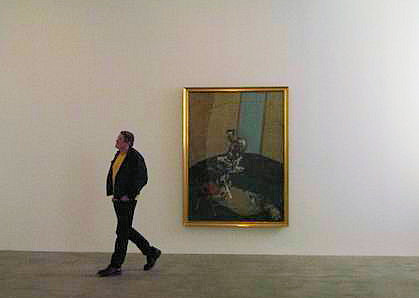
Francis Bacon: Triptychs
Whilst
I have seen the Bacon Retrospective at the Tate
(1985), Francis Bacon: The Human Body, Hayward,
(1998), Francis Bacon, Millenium Galleries, Sheffield
(2001), and Francis Bacon: The Sacred and the Profane,
Paris (2004),
the Gagosian Gallery’s Francis Bacon: Triptychs
exhibition has at last really revealed Bacon to me in
a new light. Light is the key here: the natural light
coming from overhead fanlights illuminating the paintings
and making the paint appear more serene and translucent
and evanescent than ever before.
The Gagosian, tucked
away in Kings Cross, is an alluring and seductive gallery
where the paintings can really begin to breathe and appear
to be in their own space and show their true colours:
the paintings can almost be heard as well – crackling
under the heat of the light. As the light changes so do
the mood and the sensations of the paint (which is the
image in itself). The natural lighting helps the shape-shift,
the mood and the movement of the paintings. Not only were
all the paintings superbly lit but also sublimely spatially
set out, with all the paintings having space to breathe.
This must be one of the most elegant, spare yet sympathetic
exhibition spaces in London.
It
has become a tired cliché to associate Bacon’s imagery
with ‘horror’, ‘terror’, and ‘violence’; – as ‘the ugly’,
‘the grotesque’ and ‘distorted’: yet none of these sensational
media-motifs apply to the moods and the sensations of
seeing ‘Bacon in the light’ (rather than ‘Bacon in the
flesh’).
His
calm and collective imagery displayed under the illuminating
setting of this elegant gallery reveals a serene and spiritual,
meditative and radiant – even humorous Bacon: several
visitors laughed out loud whilst imitating the out-stretched
arms of a laughing Pope (Portrait of a Pope with Two
Owls, 1957-58).
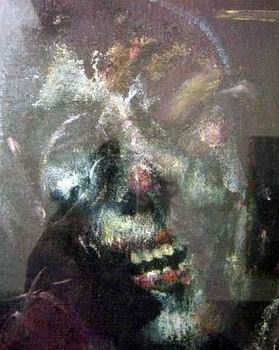
Like
Martin Heidegger, Bacon never asked himself: “What
is spirit?” and being a non-believer, Bacon preferred
to use the terms ‘pulsation’, ‘energy’
or ‘emanation’ rather than the 'soul' or the
'spirit' of the sitting subject. But by painting out of
the subconscious plane, the 'spirit' for Bacon: "seems
to come straight out of what we call the unconscious with
the foam of the unconscious locked around it - which is
its freshness." (Interviews with Francis Bacon,
David Sylvester, Thames & Hudson, 1987).
In Triptych May June 1973, (1973) and In Memory
of George Dyer (1971) we see the spirit of Dyer in
the form of smeared white paint and a thrown whiplash
of paint that has the sensation of a shimmering shudder
– like a fleeting ‘ectoplasmic’ flash emanating from the
body of Dyer. If one wondered what the ‘soul’ or ‘spirit’
ever looked like here Bacon has got close to it through
non-illustrational (non-narrative) paint.
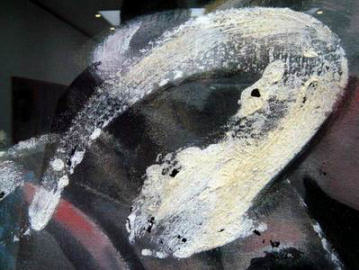
The
triptych portraits also reveal the spiritual side of Bacon
and have similar meditative moods to Alexej von Jawlensky’s
Abstract Heads and Meditations. It would have been far
more apt to juxtapose Bacon with Jawlensky than Hirst.
In Triptych 1976 (1976) Bacon uses egg-like yellow
and white discs similar to the way Jawlensky uses them
as punctuating points of the spirit where the colour and
size of the egg-disc gives off a certain mood-sensation
of the psyche / spirit. They appear again in Three
Studies for Self-Portrait (1976) and Three Studies
for a Portrait of Peter Beard (1975).
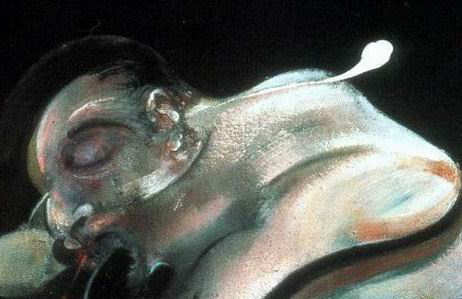
The
left-hand panel of Three Studies for a Self-Portrait
(1967) is one of Bacon’s finest self-portraits, and has
a subdued, sullen mood with the paint applied in a dry
dragged way across the cheek with the skin of the canvas
becoming the flesh. The grainy drag of the dry paint causes
a classic goose-bump, shuddering sensation.
This
sensation is also felt in the central panel of Three
Studies of Isabella Rawsthorne (1966), where Bacon
again uses arbitrary white stabs and smears of paint impressed
with a rag (torn from corduroy trousers) to suggest the
spirit of the subject or ‘all the pulsations of the
person’ – as Bacon would say about what he’s trying
to trap.
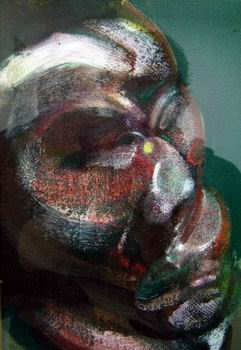
In
the room with the single paintings three were hung on
walls all on their own, thus enhancing their power all
the more: having one painting on each wall is so spatially
aware and chic. One of these paintings is the rarely seen
Crouching Nude (1961) which reminded me of the
supermarket alien woman in John Carpenter’s film ‘They
Live’. Here Bacon is reminiscent of Degas’ pastels
of woman-as- animal, with the crouching nude looking very
cat-like, grinning contemplatively – hands and feet reduced
to mere stumps.
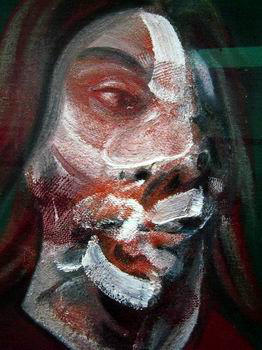
Bacon’s
use of the triptych format was initially and essentially
a strategy to avoid what he termed as the ‘boredom
of story-telling’ where an isolated image all on its
own can avoid setting up ‘the banality of a narrative’.
(This was also the case with the gallery’s decision not
to have labels by each painting, since these detract from
the image with inane information). The triptych in Bacon
is often misinterpreted as his early interest in cinema
where he saw things as serialised sequences – yet Bacon’s
triptychs are not serial images but severed images, each
one alienated from the other.
Damien
Hirst: A Thousand Years and Triptychs
Larry
Gagosian’s high-risk strategy of juxtaposing Hirst with
Bacon has backfired and become a cruel and humiliating
joke at Mr Hirst’s expense; I would personally like to
express my sincere commiserations to Hirst for any hurt
caused. Mr Gagosian has unwittingly exposed the tawdry
banality of Mr Hirst’s ‘things’.
This
dual exhibition revealed that Hirst is simply not Bacon’s
successor because Bacon’s enduring ‘art’ is the absolute
antithesis of Hirst’s ephemeral ‘things’. One is a genius
– the other is not. Whereas Bacon deals with living ‘beings’,
Hirst deals with dead ‘things’. Whilst Hirst uses real
‘things’ (sheep, butterflies and a severed bull’s head
in a pool of blood) they all look so uncannily unreal
and lack realism because Hirst has not been able
to ‘reinvent realism’ as Bacon does. Hirst likes to leave
‘things the way they are’ – hence his hyper-conservatism
with the wish to ‘preserve’ things.
By
juxtaposing Hirst with Bacon we can immediately see the
superiority of Bacon’s ‘art’ and the way it has been able
to survive the wrath of critics and time alike – whilst
Hirst’s ‘things’ already look so tired and dated – Hirst
is just a temporary media - manufactured phenomenon. Whilst
with Bacon one has a sensation of the shudder and a nervous
tension – there is absolutely no tension or sensation
or shudder in Hirst’s dreary ‘things’.
Hirst’s
infantile desire to shock merely displays his petty-bourgeois
mentality whilst Bacon – being an aristocrat of the abject
sublime – has no need to shock. Go along to make up your
own minds.
Alex Russell
‘Francis Bacon: Triptychs’ and ‘Damien Hirst:
“A Thousand Years” and Triptychs’, Gagosian Gallery, 6-24
Britannia Street,
London WC1,
tel +44 020 7841 9960; ‘Pablo Picasso: La Minotauromachie’,
Gagosian Gallery, London W1, tel +44 020 7493 3020; all
to August 4th 2006.

